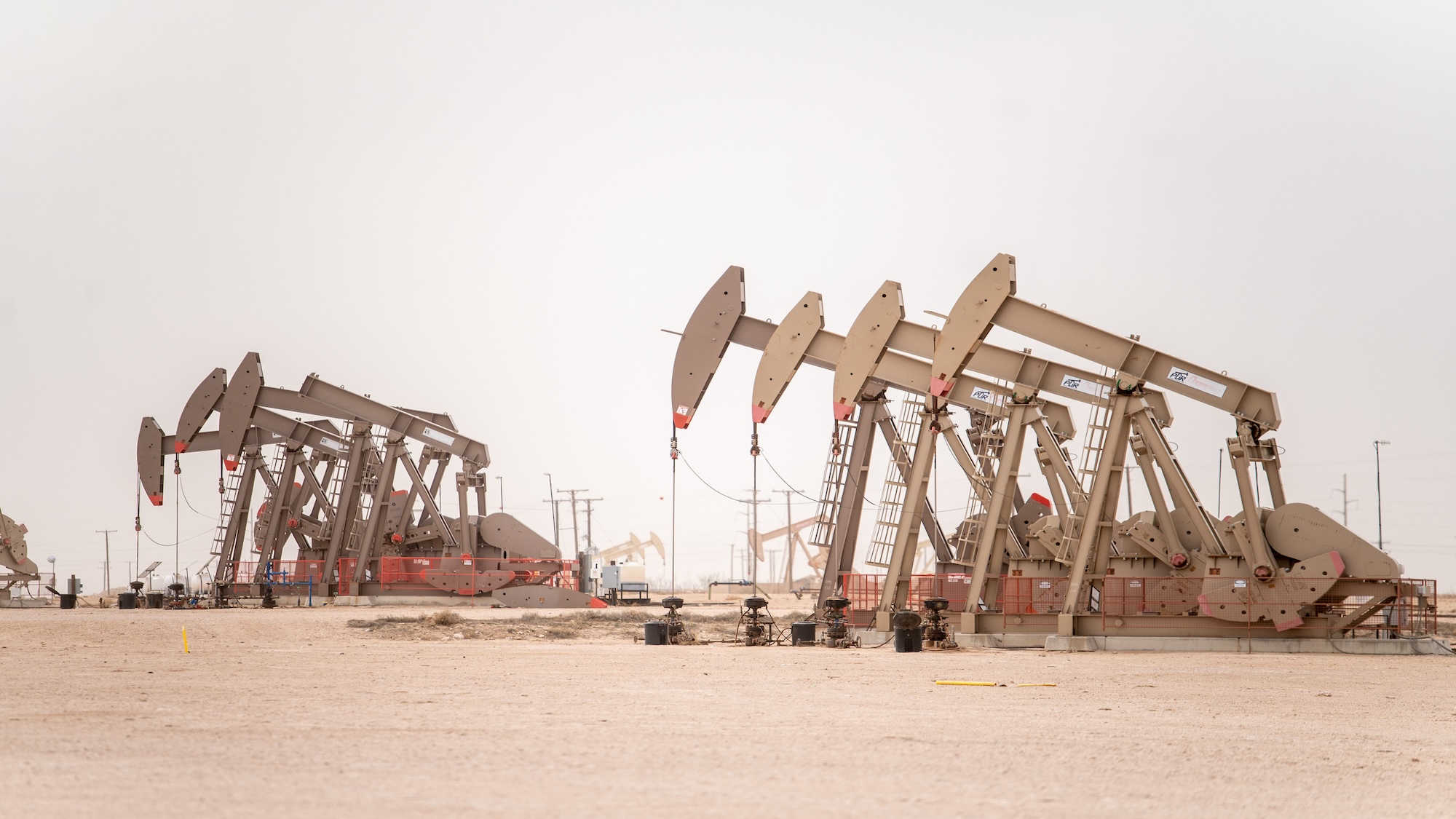Oil price posts two-year highs - but how long can it last?
Brent rose above $59 a barrel this week, its best third-quarter showing since 2004

Oil price fails to make big gains despite Opec cuts
14 February
The oil price has failed to break out of its mid-$50s range, despite data from the powerful Opec cartel showing its members are sticking to a deal to cut production.
Figures published yesterday revealed the 14-nation group's output declined by 890,000 barrels a day to 32.14 million barrels a day in January, says MarketWatch.
The Week
Escape your echo chamber. Get the facts behind the news, plus analysis from multiple perspectives.

Sign up for The Week's Free Newsletters
From our morning news briefing to a weekly Good News Newsletter, get the best of The Week delivered directly to your inbox.
From our morning news briefing to a weekly Good News Newsletter, get the best of The Week delivered directly to your inbox.
Analysts say that means the organisation is already 90 per cent compliant with the cuts it agreed at the end of last November and that the headline figure is actually below the targeted total of 32.5 million barrels a day.
All of which should increase confidence that the supply overhang in the market will begin to be eroded: Opec itself predicts the market will be in supply deficit by the second half of this year.
But the oil price at first dipped slightly yesterday and while it has moved higher today, it remains rooted in its narrow recent range.
Brent crude, the international oil price benchmark, rose 1.2 per cent this morning to $56.24 a barrel, while its US counterpart, West Texas Intermediate, increased by the same margin to $53.58 a barrel.
A free daily email with the biggest news stories of the day – and the best features from TheWeek.com
Oil has doubled in value compared to its nadir this time last year and is up by around a third since the final agreeing of the Opec deal, which also includes cuts by non-Opec members such as Russia.
However, forecasts that it would push on to $60 or even $70 and beyond in quick succession have so far failed to come true.
Reuters says the oil price might be capped by investor doubts over whether the producers will stick to their promises long enough to see a significant run-down of reserve, which have built up in the past two years.
"Lessons from the past have made the market deeply suspicious," Hans van Cleef, senior energy economist at ABN Amro, said.
MarketWatch also highlights data showing US shale oil production increasing since oil prices rose above $50 earlier this year.
Data from the US energy department revealed output hit a ten-month high of close to nine million barrels a day earlier this month, while a report later today is expected to show crude reserves rose again last week, by 3.2 million barrels.
BP needs oil to rise to $60 to break even
8 February
BP says it needs oil prices to rise substantially this year in order to balance its capital spending and cash flow, according to The Times.
Having previously said it would break even in cash terms at an oil price of between $50 and $55 – a level at which BP has been trading solidly since the end of the year – the company now says it needs oil to fetch $60 a barrel.
BP made the admission in its fourth-quarter results, which reveal that last year, when the oil price averaged $44 a barrel, the oil giant made a total loss of around $1bn (£800m).
This was in part due to compensation costs relating to the Deepwater Horizon explosion and subsequent oil spill in the Gulf of Mexico – BP's provision was upped by $800 (£640) to $62.6bn (£50bn) at the end of last year.
For the final three months of the year only, the company made an underlying operational profit of $400m (£319m), "more than double the same period in 2015 but below analysts' forecasts of $560m (£447m).
As a result, BP became the latest oil major to report underwhelming figures, disappointing traders hoping to find evidence that the industry had reached an inflection point after Shell last week fell $1bn (£800m) short of analyst expectations.
The news – and the target of $60 for the oil price – came on the day that the international oil price, Brent crude, fell back below $55 a barrel.
Benchmark prices have been stubbornly rooted around the mid-$50s since the start of the year, amid hopes that a supply cut by Opec and others would rebalance the market and concern over renascent US shale production.
This could keep the oil price below the $60 threshold for some time unless there is statistical supply evidence that proves the market has moved sustainably into deficit against demand.
Oil price returns to 'pivot point' after fastest fall in three weeks
7 February
The oil price suffered its fastest fall since mid-January yesterday as concern continued over the market impact of recovering US shale oil output.
From lows in the low-$40s per barrel last November, international oil recovered to the mid-$50s per barrel earlier this year when the powerful Opec cartel, Russia and other major producers agreed to cut 1.8 million barrels a day from their production.
Signs that they are so far honouring the terms of the deal pushed oil up two per cent last week, to above $57 a barrel at one point.
But yesterday Brent crude, the international oil price benchmark, fell almost two per cent a barrel to around $55.70 a barrel. It was the worst one-day performance since 18 January, according to MarketWatch.
In large part this decline is a response to data from Baker Hughes showing the number of active US shale rigs rising for the third consecutive week last week. Traders fear this will undermine the rebalancing efforts of the production cuts elsewhere.
Evidence shows that US rigs that are currently active are getting more efficient at extracting shale oil. This suggests that production in the sector could rise at an even faster rate.
Societe Generale oil analyst Michael Wittner told Reuters that "US shale oil output was recovering faster than expected as more oil rigs drilled better and more efficient wells more quickly."
Analysts have also pointed to a stronger dollar so far this year, which weighs on overseas demand for dollar-denominated commodities like oil.
There are concerns over underwhelming demand, prompted by the fact that US stockpiles have jumped 21 million barrels in the first month of the year and by data that shows that the weakest demand growth in China for three years was in 2016.
Despite the drop-back, however, oil remains rooted in the mid-$50s at what Matt Stanley, a fuel broker with Freight Investor Services in Dubai, describes as its "pivot point".
This means it's poised to move significantly higher or lower in the medium term, once the direction of the market in terms of supply becomes clearer.
Shell fails to deliver oil price 'inflection point'
2 February
After a brutal two-and-a-year oil price slump, this was meant to be the week that marked an "inflection point" for the oil majors.
Last Saturday, the Daily Telegraph reported analyst estimates that Shell would today announce annual profit doubled in 2016, with the recovery of the oil price from its February 2016 low boosting margins around the world.
It was also predicted this would be followed by positive reports from the likes of BP, ExxonMobil and Total in the weeks to come.
However, Shell failed to deliver: its fourth-quarter profits did rise on an underlying basis, but by much less than expected, while full-year adjusted earnings actually fell.
For the final three months of the year, the company made $1.8bn (£1.4bn) of operational profit before one-off adjustments, well down on the anticipated $2.8bn (£2.2bn).
Taking into account writedowns, expenses and a $500m (£395m) tax-hit related to currency movements, the measure of earnings "most closely watched by investors" fell to $1bn (£790m) from $1.8bn (£1.4bn) last year, says the Financial Times.
On the same basis, profit for 2016 as a whole came in at $3.5bn (£2.75bn), reports the BBC, down from $3.8bn (£3bn) last year and well short of analyst forecasts for $8.2bn (£6.9bn).
The issues at Shell mostly relate to its acquisition of BG Group and tax re-calculations, however, and are not being seen as a reflection of a negative underlying position.
In fact, with the oil price continuing to make strides and Shell repositioning itself to focus on higher-margin markets after selling billions of pounds worth of assets this week, investors were broadly pleased and its shares rose 1.8 per cent.
The oil price was also up, with international benchmark Brent crude adding one per cent to go above $57 a barrel this morning.
However, it has been held back from challenging the $60 threshold by reports yesterday showing a 6.5 million-barrel rise in US crude stockpiles last week, says Reuters.
Coupled with ongoing increases in US shale oil drilling, the data adds to a bearish case on global supply that is expected to act as a drag on oil for some time to come.
Oil price slump to end tax-free living in Saudi Arabia
31 January
A two-and-a-half year slump in the oil price has put an end to the tax-free life of people in Saudi Arabia after its government approved a "value-added tax to be imposed across the Gulf", says The Guardian.
Backed by the International Monetary Fund and agreed with the Gulf Cooperation Council, a political union that includes as members Bahrain, Kuwait, Oman, Qatar and the United Arab Emirates, the five per cent tax will be applied selectively on some goods.
The IMF has formally recommended Gulf states "impose revenue-raising measures including excise and value-added taxes to help their adjustment to lower crude prices," says the Guardian.
Saudi Arabia imposes no personal income or consumption taxes on residents and raises revenue primarily from oil exports and modest levies on businesses and capital gains.
But since the oil price has collapsed from well above $100 a barrel in the summer of 2014 to a low of $27 in February 2016, the kingdom has struggled financially and posted a record budget deficit of $97bn (£78bn) last year.
In response, its government "froze major building projects, cut cabinet ministers’ salaries and imposed a wage freeze on civil servants".
The country is also in the process of "broadening its investment base and boosting other non-oil income as part of economic diversification efforts".
That's important in the context of widespread belief among industry experts and analysts, including oil major BP, that the oil price may never again return to its $100+ highs.
Right now, the commodity is still in the mid-$50s, with international oil price benchmark Brent crude rising 0.7 per cent today to $55.60.
Reuters says the modest increase followed survey data showing the Opec cartel has already implemented one million barrels of its promised 1.2 million barrels-per-day cut to output that was agreed last November.
As has been the case for the past two months, however, gains are being capped by data showing an increase in drilling in the US shale oil sector to take advantage of the oil price rebound.
-
 A lemon-shaped exoplanet is squeezing what we know about planet formation
A lemon-shaped exoplanet is squeezing what we know about planet formationUnder the radar It may be made from a former star
-
 Political cartoons for January 4
Political cartoons for January 4Cartoons Sunday's political cartoons include a resolution to learn a new language, and new names in Hades and on battleships
-
 The ultimate films of 2025 by genre
The ultimate films of 2025 by genreThe Week Recommends From comedies to thrillers, documentaries to animations, 2025 featured some unforgettable film moments
-
 How might the Israel-Hamas war affect the global economy?
How might the Israel-Hamas war affect the global economy?Today's Big Question Regional escalation could send oil prices and inflation sky-high, sparking a worldwide recession
-
 Recent mega-mergers could signal a turning point for the US oil industry
Recent mega-mergers could signal a turning point for the US oil industryTalking Point Both Chevron and Exxon have recently spent billions to acquire smaller oil companies
-
 Has Saudi Arabia lost control of oil prices?
Has Saudi Arabia lost control of oil prices?Today's Big Question Kingdom goes it alone to cut production, risking tension with US and reigniting cooling inflation in Europe
-
 US angered by Opec+ oil cut
US angered by Opec+ oil cutSpeed Read Energy prices to rise further as producers slash supply by two million barrels a day
-
 Global oil demand forecast lowered for 2020 and 2021
Global oil demand forecast lowered for 2020 and 2021Speed Read IEA report says jet fuel demand remains the major source of weakness
-
 Are US-Iran tensions flaring again?
Are US-Iran tensions flaring again?In Depth Trump threatens military action over Twitter
-
 Can a deal be struck to raise oil prices?
Can a deal be struck to raise oil prices?In Depth Opec+ will convene today over video link in a bid to boost crude
-
 What do negative oil prices mean?
What do negative oil prices mean?In Depth Perfect storm of oversupply and storage shortages sees producers paying to get rid of US crude